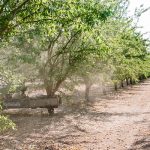Nonpareil nuts are on the orchard floor. This variety, 52% of the whole, bloomed first and harvest was begun. The Butte, Fritz, and Monterey follow in order and the process will span the remaining hot/dry season. Our tree rows are interspersed by design and the harvester must exercise care that the fruit varieties are not intermixed. Nonpareil is the more desireable and commands the best price category for its shape and size. Contamination with another variety (a no-no) reduces the grade to that of mixed nuts — the lowest price.
The nuts are separated from tree by shaking. In early days this was done by laborers hand-knocking with sticks (poling), but is now mechanized due to the shear volume. The nuts in the center of the tree are the last to ripen. Moisture readings ~10% can be monitored. The nuts can be more difficult to dislodge if the hulls dry too much on tree but a test shake or two are usually the best indication that determine readiness. Optimum nut removal is 96 to 99%. Those that are left behind are not considered part of the harvest yield and become part of the orchard sanitation clean up proces$.
In early days this was done by laborers hand-knocking with sticks (poling), but is now mechanized due to the shear volume. The nuts in the center of the tree are the last to ripen. Moisture readings ~10% can be monitored. The nuts can be more difficult to dislodge if the hulls dry too much on tree but a test shake or two are usually the best indication that determine readiness. Optimum nut removal is 96 to 99%. Those that are left behind are not considered part of the harvest yield and become part of the orchard sanitation clean up proces$.
It’s a balancing act and a bit of a calculated race against nature as there is the eminent threat of Navel Orange Worm (NOW) and onset of early fall rain. The harvest is a significant [25%] portion of the expense budget. It is crucial that the process not begin before nut maturity but be complete before NOW pest infestation or mold issues. A too early harvest can result in excessive sticktights or curled hulls. They are a challenge mechanically and are graded as foreign matter in the delivery, a penalty.
Once on the ground the nuts must be left to dry for 1 to 2 weeks. Rain would be a detriment at this point. The machinery that process the nuts at the hulling site are impaired when nut moisture levels are too high. Almonds received in excess of 6.5% w.b. must undergo the expense of mechanical drying. Almonds are contractually weight adjusted to a 5% ceiling. On the other hand, realise that we are paid by the pound and that moisture equals weight. Therefore 5% seems like a good target and we check the moisture statistic on the Grower Delivery Report at the end of the day.
Next: Sweeping and Pickup
great picture! did you take that?
Shamelessly lifted from the Almond Board of California. They are the PR arm for the industry. Their big task, when they’re not promoting nut nutrition/health, is to deflect the notion that Almond Growers use more than a reasonable share of California”s water resources.
Besides additional moisture, are there any other conditions that would be detrimental to the almonds on the orchard floor?
Thanks! ~C
Not for the almond nuts per se but yes, at this point the trees are fairly thirsty if not stressing. Some trees will drop their leaves. The orchard floor has to be kept dry while the nuts dry. Nuts must be picked up as soon as possible so that irrigation may resume.